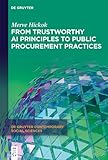From Trustworthy AI Principles to Public Procurement Practices / Merve Hickok.
Material type: TextSeries: De Gruyter Contemporary Social Sciences ; 36Publisher: Berlin ; Boston : De Gruyter, [2024]Copyright date: 2024Description: 1 online resource (IX, 246 p.)Content type:
TextSeries: De Gruyter Contemporary Social Sciences ; 36Publisher: Berlin ; Boston : De Gruyter, [2024]Copyright date: 2024Description: 1 online resource (IX, 246 p.)Content type: - 9783111249971
- 9783111250434
- 9783111250182
- online - DeGruyter
- Issued also in print.
| Item type | Current library | Call number | URL | Status | Notes | Barcode | |
|---|---|---|---|---|---|---|---|
 eBook
eBook
|
Biblioteca "Angelicum" Pont. Univ. S.Tommaso d'Aquino Nuvola online | online - DeGruyter (Browse shelf(Opens below)) | Online access | Not for loan (Accesso limitato) | Accesso per gli utenti autorizzati / Access for authorized users | (dgr)9783111250182 |
Browsing Biblioteca "Angelicum" Pont. Univ. S.Tommaso d'Aquino shelves, Shelving location: Nuvola online Close shelf browser (Hides shelf browser)

|

|

|

|

|

|

|
||
| online - DeGruyter Geschwister-Logik : Genealogisches Denken in der Literatur und den Wissenschaften der Moderne / | online - DeGruyter Romance motion verbs in language change : Grammar, lexicon, discourse / | online - DeGruyter Ruth Schnell – WORKBOOK : Mirrors of the Unseen / | online - DeGruyter From Trustworthy AI Principles to Public Procurement Practices / | online - DeGruyter Welches Wissen (und welche Wissenschaft) braucht die Politik? : Herausforderungen wissensbasierter Demokratie / | online - DeGruyter VWL-Klausuren : Ein Übungsbuch / | online - DeGruyter The Jewish Community of Acre in Mandatory Palestine : The Story of a Forgotten Community / |
Frontmatter -- Contents -- Introduction -- Chapter 1 Procurement as a Policy Enabler -- Chapter 2 Stages of Procurement -- Chapter 3 Why Is Procurement of AI Different? -- Chapter 4 Trustworthiness -- Chapter 5 Policy and Value (Mis)alignment -- Chapter 6 Organizational Capability and Capacity -- Chapter 7 Data and Model Performance -- Chapter 8 Fairness -- Chapter 9 Socio-Technical Systems -- Chapter 10 Transparency -- Chapter 11 Safety and Security -- Chapter 12 Distributed Responsibility -- Chapter 13 Oversight and Accountability -- Chapter 14 Are Generative AI Systems Different? -- Chapter 15 Conclusion and Recommendations -- Appendix I Expert Interview Questions -- Appendix II Procurement Questions as per Sections -- Bibliography -- Index
restricted access online access with authorization star
http://purl.org/coar/access_right/c_16ec
This book is an early warning to public officials, policymakers, and procurement practitioners on the impact of AI on the public sector. Many governments have established national AI strategies and set ambitious goals to incorporate AI into the public infrastructure, while lacking AI-specific procurement guidelines. AI is not traditional software, and traditional processes are not sufficient to meet the challenges AI brings. Today’s decisions to embed AI and algorithmic systems into public system infrastructure can – and will – have serious repercussions in the future.The promise of AI systems is to make the public sector more efficient, effective, fair, and sustainable.However, AI systems also bring new and emerging risks which can impact rights and freedoms. Therefore, guardrails are necessary to consider the socio-technical dimensions and impact on individuals, communities, and society at large.It is crucial that public sector decision-makers understand the emerging risks of AI systems, the impact on the agency and the wider public infrastructure, and have the means to independently validate vendor claims. This book is a result of interviews with more than 20 public procurement professionals across countries, offering an in-depth analysis of the risks, incidents, governance practices, and emerging good practices around the world, and provides valuable procurement policy and process recommendations to address and mitigate these risks.
Issued also in print.
Mode of access: Internet via World Wide Web.
In English.
Description based on online resource; title from PDF title page (publisher's Web site, viewed 20. Nov 2024)


